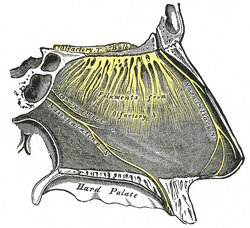Assessment |
Biopsychology |
Comparative |
Cognitive |
Developmental |
Language |
Individual differences |
Personality |
Philosophy |
Social |
Methods |
Statistics |
Clinical |
Educational |
Industrial |
Professional items |
World psychology |
Biological: Behavioural genetics · Evolutionary psychology · Neuroanatomy · Neurochemistry · Neuroendocrinology · Neuroscience · Psychoneuroimmunology · Physiological Psychology · Psychopharmacology (Index, Outline)
| Nerve: Olfactory nerve | ||
|---|---|---|
| [[Image:{{{Image2}}}|250px|center|]] | ||
| {{{Caption2}}} | ||
| Latin | nervus olfactorius | |
| Gray's | subject #196 | |
| Innervates | ||
| From | ||
| To | ||
| MeSH | A08.800.800.120.640 | |
The olfactory nerve, or cranial nerve I, is the first of twelve cranial nerves. The specialized olfactory receptor neurons of the olfactory nerve are located in the olfactory mucosa of the upper parts of the nasal cavity. The olfactory nerves do not form two trunks like the remaining cranial nerves, but consist of a collection of many sensory nerve fibers that extend from the olfactory epithelium to the olfactory bulb, passing through the many openings of the Cribriform plate of the Ethmoid bone; a sieve-like structure.
Olfactory receptor neurons continue to be born throughout life and extend new axons to the olfactory bulb. Olfactory ensheathing glia wrap bundles of these axons and are thought to facilitate their passage into the central nervous system.
The sense of smell (olfaction) arises from the stimulation of the olfactory receptors by activation from gas molecules that pass by the nose during respiration. The resulting electrical activity is transduced into the olfactory bulb which then transmits the electrical activity to other parts of the olfactory system and the rest of the central nervous system via the olfactory tract.
The olfactory nerve is the shortest of all the twelve cranial nerves and only one of two cranial nerves (the other being the optic nerve) that do not join with the brainstem.
Testing the Olfactory nerve
To test the function of the olfactory nerve, doctors block one of the patient's nostrils and place a pungent odor (such as damp coffee essence) under the open nostril. The test is then repeated on the other nostril.
| Cranial Nerves |
|---|
| CN 0 - Cranial nerve zero |
| CN I - Olfactory |
| CN II - Optic |
| CN III - Oculomotor |
| CN IV - Trochlear |
| CN V - Trigeminal |
| CN VI - Abducens |
| CN VII - Facial |
| CN VIII - Vestibulocochlear |
| CN IX - Glossopharyngeal |
| CN X - Vagus |
| CN XI - Accessory |
| CN XII - Hypoglossal |
Lesions of the Olfactory nerve
Lesions to the Olfactory nerve often lead to a reduced ability to taste and smell. However, ammonia can still be detected by the pain fibers of the Trigeminal nerve. They can occur because of blunt trauma, such a coup-contra-coup damage, meningitis and tumors of the frontal lobe.
Additional images
See also
References & Bibliography
Key texts
Books
Papers
Additional material
Books
Papers
External links
I-IV: olfactory - optic - oculomotor - trochlear
V: trigeminal: trigeminal ganglion
V1: ophthalmic: lacrimal - frontal (supratrochlear, supraorbital) - nasociliary (long root of ciliary, long ciliary, infratrochlear, posterior ethmoidal, anterior ethmoidal) - ciliary ganglion (short ciliary)
V2: maxillary: middle meningeal - in the pterygopalatine fossa (zygomatic, zygomaticotemporal, zygomaticofacial, sphenopalatine, posterior superior alveolar)
in the infraorbital canal/infraorbital nerve (middle superior alveolar, anterior superior alveolar)
on the face (inferior palpebral, external nasal, superior labial, infraorbital plexus) - pterygopalatine ganglion (deep petrosal, nerve of pterygoid canal)
branches of distribution (palatine, nasopalatine, pharyngeal)
V3: mandibular: nervus spinosus - medial pterygoid - anterior (masseteric, deep temporal, buccal, lateral pterygoid)
posterior (auriculotemporal, lingual, inferior alveolar, mylohyoid, mental) - otic ganglion - submandibular ganglion
VI: abducens
VII: facial: nervus intermedius - geniculate - inside facial canal (greater petrosal, nerve to the stapedius, chorda tympani)
at exit from stylomastoid foramen (posterior auricular, digastric - stylohyoid)
on face (temporal, zygomatic, buccal, mandibular, cervical)
VIII: vestibulocochlear: cochlear (striae medullares, lateral lemniscus) - vestibular
IX: glossopharyngeal: fasciculus solitarius - nucleus ambiguus - ganglia (superior, petrous) - tympanic - carotid sinus
X: vagus: ganglia (jugular, nodose) - Alderman's nerve - in the neck (pharyngeal branch, superior laryngeal ext and int, recurrent laryngeal)
in the thorax (pulmonary branches, esophageal plexus) - in the abdomen (gastric plexuses, celiac plexus, gastric plexus)
XI: accessory XII: hypoglossal
Sensory system: Olfactory system / Olfaction / Rhinencephalon (TA 15.1, GA 10.992) | |
|---|---|
| Olfactory epithelium | |
| Olfactory nerve: 1° neuron |
Olfactory receptor neurons (Olfactory receptor) → Olfactory bulb (Glomeruli) |
| Olfactory nerve: 2° neuron | |
| Lateral olfactory stria/ Primary olfactory cortex |
Piriform cortex · EC-hippocampus system (Entorhinal cortex, Hippocampal formation) · Prepyriform area · Periamygdaloid cortex Stria medullaris → Habenular nuclei |
| Medial olfactory stria | |
| Template:Olfaction navs | |
| This page uses Creative Commons Licensed content from Wikipedia (view authors). |
